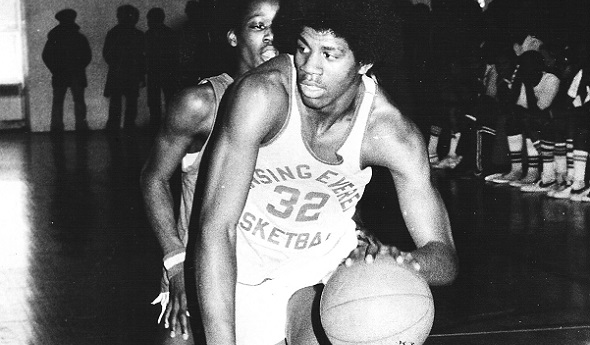
'Retro' Award Rewards 1st Hoops Legends
January 4, 2017
By Ron Pesch
Special for Second Half
Before the start of the MHSAA’s 2009 Boys Basketball finals, Basketball Coaches Association of Michigan director Tom Hursey stopped by my seat at Michigan State University’s Breslin Center to say hello.
Our chat would alter a decade of my Michigan winters.
Somewhere between hello and goodbye, our chat included conversation on one of my favorite BCAM ventures. In 1981, the Michigan High School Basketball Coaches Association, as BCAM was once known, named its first “Mr. Basketball.” I was two years out of high school when Lansing Eastern’s Sam Vincent edged Eric Turner of Flint Central for that first award. Designed to honor the state’s top senior, the award was named in honor of Detroit Free Press writer Hal Schram. “The Swami,” as he was nicknamed, Schram began covering high school sports for the newspaper in 1945.
The 2009 selection was 6-foot-9 Derrick Nix of Detroit Pershing. I mentioned my affinity for the Mr. Basketball program to Tom, but stated that I always thought it a crime that the award didn’t start years earlier, at least when Michigan hoop fans became infatuated with a kid nicknamed “Magic.”
Earvin Johnson prepped at Lansing Everett and was the talk of the state in basketball circles before becoming a household name during his time at Michigan State and with the Los Angeles Lakers. Earlier this year, ESPN named Johnson the greatest point guard to ever play the game. Tom noted that “Magic” was really the inspiration for the “Mr. Basketball” award.
Then I posed a question to Tom.
What about creating a “new” award, designed to honor those greats from the past?
As my hobby of researching the history of high school sports in Michigan and beyond had grown over the years, I’d found the Great Lakes state had always produced shining stars on the basketball court. The crime was that the “Mr. Basketball” award hadn’t been launched many years before.
Harry Kipke, was perhaps the state’s first true basketball star. He won 12 varsity letters at Lansing Central and guided the basketball team to the semifinal round of the state tournament in 1920 as a senior, before heading to the University of Michigan where he earned letters in football, basketball and baseball. After stops at the University of Missouri and Michigan State, Kipke would serve as Michigan’s football coach, guiding the Wolverines to two national gridiron championships.
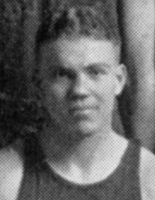 As a junior, the basketball antics of Grand Rapids Union’s Royal “Red” Cherry captured the state’s attention when he led Union to the state basketball championship. Considered the best all-around player of the tournament, Cherry led the team to a second consecutive title as a senior. He, too, attended Michigan, earning laurels on the basketball court and the baseball diamond.
As a junior, the basketball antics of Grand Rapids Union’s Royal “Red” Cherry captured the state’s attention when he led Union to the state basketball championship. Considered the best all-around player of the tournament, Cherry led the team to a second consecutive title as a senior. He, too, attended Michigan, earning laurels on the basketball court and the baseball diamond.
Many other legends of the hardcourt populated Michigan’s past: Saginaw’s Ernie Thompson; the Burton brothers, M.C. and Ed, of Muskegon Heights; Detroit Pershing’s Ralph Simpson and Spencer Haywood; Dave DeBusschere of Detroit Austin Catholic; Willie Betts and Blanche Martin of River Rouge; Ron Kramer of East Detroit; Benton Harbor’s Chet Walker and L.C. Bowen.
After a few weeks of research, discussion and thought, Tom agreed, and over the next several months the framework for the “Retro Mr. Basketball” project was developed
The idea was to try and mimic the current model. Only seniors, and their high school basketball careers, should be considered. While any “senior” player would be eligible, a ballot of the state’s elite would comprise the candidates for the award. Like their modern-day equivalents, where the events of life that would follow high school graduation had yet to occur, post-high school life would be disregarded as much as possible for “Retro” candidates.
Finally, the program would follow a 10-year arc, kicking off in the spring of 2010. This December marks my eighth year of research tied to the mission. Two more will follow.
Since the Schram “Mr. Basketball” award began in 1981, the “Retro” award would honor basketball players from the years 1920 through 1980. That first year, a ballot comprised of players from the years that ended in zero - 1920, 1930, 1940, 1950, 1960, 1970 and 1980 – was created. A senior for each year would be named the winner of the “Retro” award. That meant with the selection of “Mr. Basketball” and the six “Retro” winners for the years 1929, 1939, 1949, 1959, 1969 and 1979, scheduled for the spring of 2019, BCAM would be able to point to a combined list of Mr. Basketballs totaling 100 of the state’s finest.
To identify each year’s award winner, a committee of veteran BCAM members was formed to study a ballot of candidates and select a winner.
Technology, combined with scanning old-fashioned reels of microfilm, has helped with research of potential candidates. In those very early years, personal statistics were rarely kept. Rather, an assessment of a player’s skills, tied to the position he played, often served as a means to identify an area’s top athletes. Tournament play was often the only time an athlete’s abilities were on display to a larger audience. Scouring newspaper articles for all-tournament teams and yearbooks for additional details and years of study helped uncover the state’s top senior players. Understanding the game and its evolution was important. The center jump after each basket emphasized the importance of a tall, skilled center in those games played before the winter of 1938-39.
Beginning in 1935, all-state teams began to appear in state newspapers. Eventually, the Detroit Free Press, the Detroit Times, the Detroit News, The Associated Press and even United Press International became involved in identifying the state’s top basketball players and naming all-state squads. Much work is involved in parsing the 15,811 names (not including honorable mentions) found in those lists. When duplicates are removed, the names of 8,430 prep players remain spread over the 61 years that mark the “Retro” field of possible candidates.
Research to identify seniors, players named by multiple media outlets, and mini biographies are compiled for the top players. The field of candidates is then narrowed to 10 or fewer. Over state championship weekend, the ballots are brought to the BCAM committee for discussion, and finalists are named for each year. Finally, one player is named for each eligible season.
Like the modern day award, the selection may create some controversy. Some amazing ballplayers have landed on the finalist list, but were denied the Hal Schram Mr. Basketball award: Traverse City’s Dan Majerle, Roy Marble of Flint Beecher, Detroit Southwestern’s Jalen Rose, Detroit Northern’s Derrick Coleman and Draymond Green of Saginaw are among a few.
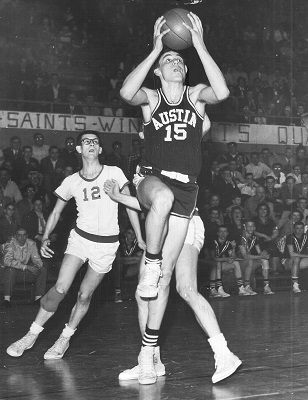 The same applies to the “Retro” list. Fennville’s Richie Jordan, Robert “Bubbles” Hawkins from Detroit Pershing, Dennis Bankey of Detroit St. Thomas, Bill Chmielewski of Detroit Redeemer, Highland Park’s Terry Duerod and Detroit Kettering’s Lindsay Hairston all have been honored on the finalist lists, but fell short of the top prize.
The same applies to the “Retro” list. Fennville’s Richie Jordan, Robert “Bubbles” Hawkins from Detroit Pershing, Dennis Bankey of Detroit St. Thomas, Bill Chmielewski of Detroit Redeemer, Highland Park’s Terry Duerod and Detroit Kettering’s Lindsay Hairston all have been honored on the finalist lists, but fell short of the top prize.
In many cases, Michigan was loaded with prep talent – it’s tough to name Roy Marble Mr. Basketball when Flint Northwestern’s Glen Rice was on the same ballot, or Rose the state’s best when Country Day’s Chris Webber was another candidate. While the “Fennville Flash” amazed the state with his eye-popping statistics in 1965, Bowen led Benton Harbor to back-to-back Class A titles. Named an all-state basketball player as a junior, Hairston grew an inch and improved his game as a senior, but Pontiac Central’s “Campy” Russell dominated headlines that season, and was the “Retro” Mr. Basketball selection for 1971.
In some cases, it’s a challenge to look at the final balloting results without judging selections based on future basketball success. That certainly is the case with 2008. That season, Michigan’s Mr. Basketball award went to 6-foot guard Brad Redford, who posted incredible back-to-back high school seasons at Frankenmuth. Runner-up to the award that year was Saginaw’s Green. Considering Green’s success in the NBA, that’s hard for many to believe.
While the debates may never be settled, the beauty of Schram and “Retro” Mr. Basketball balloting can be found in the argument. With those disputes, people recall, research and learn about Michigan’s incredible prep basketball past.
The remaining three years of the “Retro” project will include many more legends of Michigan High School basketball, including, among others, DeBusschere, Walker, Haywood and Simpson.
This season, that “Magic” kid will be one of the names among the mix. Forty years after high school graduation, will he earn the honor that eluded him in high school, only because the honor didn’t yet exist?
 Ron Pesch has taken an active role in researching the history of MHSAA events since 1985 and began writing for MHSAA Finals programs in 1986, adding additional features and "flashbacks" in 1992. He inherited the title of MHSAA historian from the late Dick Kishpaugh following the 1993-94 school year, and resides in Muskegon. Contact him at [email protected] with ideas for historical articles.
Ron Pesch has taken an active role in researching the history of MHSAA events since 1985 and began writing for MHSAA Finals programs in 1986, adding additional features and "flashbacks" in 1992. He inherited the title of MHSAA historian from the late Dick Kishpaugh following the 1993-94 school year, and resides in Muskegon. Contact him at [email protected] with ideas for historical articles.
PHOTOS: (Top) Lansing Everett’s Earvin Johnson drives around a defender during his celebrated high school career. (Middle) Grand Rapids Union’s Royal “Red” Cherry. (Below) Detroit Austin Catholic’s Dave DeBusschere drives to the hoop as an opponent gets in position to rebound. (Photos from MHSAA and Ron Pesch historical files.)
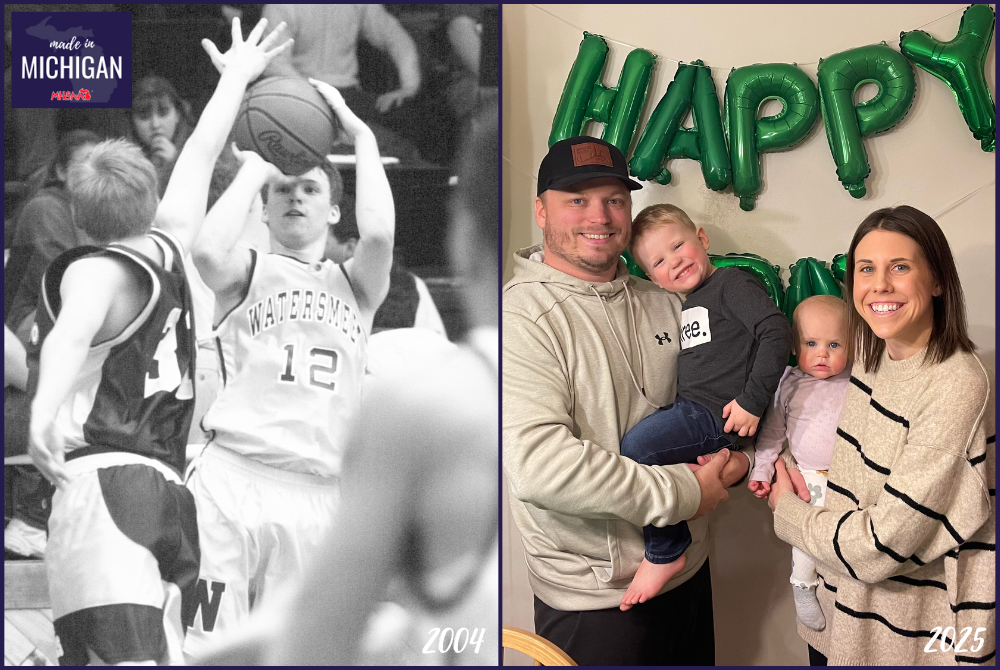
'Who Will Cheer for the Nimrods?' Peterson IV, Watersmeet Found Fans Worldwide
By
Jason Juno
Special for MHSAA.com
July 15, 2025
WATERSMEET — George Peterson IV talks to a lot of people through his job as a police officer in the Green Bay, Wis., area. When some of those folks are headed up north for the weekend, he tells them he’s from the Upper Peninsula.
 Many are expecting to hear about one of the bigger towns located a couple of hours drive from Green Bay, like Iron Mountain or Escanaba. But they usually know his hometown, too.
Many are expecting to hear about one of the bigger towns located a couple of hours drive from Green Bay, like Iron Mountain or Escanaba. But they usually know his hometown, too.
“There’s more people than I would have thought know exactly – ‘Oh Watersmeet, the Nimrods,’” Peterson said.
Some surely know the tiny town because it’s not light years away from Green Bay – only about three hours. But Watersmeet’s dot on the map got a little bigger when Peterson was in school two decades ago, thanks to a run of media exposure that all started with an ESPN commercial that wondered: Without sports, who would cheer for the Nimrods?
Peterson and his teammates can look back on a high school sports experience unlike pretty much anyone else’s, which included the popular ESPN commercial, an appearance on “The Tonight Show” with Jay Leno, and an eight-part miniseries and media exposure from print and television outlets throughout the country. All because of their quirky nickname that has come to be an insult but was chosen because the biblical figure Nimrod was a mighty hunter, and hunting is a big deal in the U.P.
That era also coincided with the best basketball Watersmeet has ever seen. The 2004-05 team, with Peterson was a junior, won its only MHSAA Regional championship and only U.P. small-school team of the year award.
“Great memories from that year,” Peterson said.
The first moments he mentions from his time in high school sports as a aren’t of going to Hollywood – although that certainly came up later – or of being on ESPN. He instead recalled the camaraderie with his teammates, the bus rides, and proving people wrong even in elementary school that Watersmeet could be good.
“The Watersmeet Nimrods weren't supposed to be good,” he said. “We weren’t supposed to win elementary tournaments; we were supposed to fall apart.”
They definitely didn’t do that, as one of the smallest high schools in the state enjoyed instead an unforgettable three-year run.
The cameras first showed up when Peterson was a sophomore. ESPN staff came to get footage early that season, during a December 2003 game against rival Bessemer. The cameras didn’t faze the Nimrods, who upset the rival Speedboys that night; Peterson remembers Bessemer putting 100 on them later that season.
No one told the Nimrods when the commercials were going to air. Then one came on one night when Peterson was watching ESPN.
“That was really cool, just little surprises you weren’t expecting,” Peterson said.
Watersmeet was featured in major newspapers, “CBS Sunday Morning” came to town, and Nimrods merchandise flew off the shelves.
They were even on “The Tonight Show.”
“I would say Jay Leno was probably the coolest experience,” Peterson said. “A small-town kid from Watersmeet, all of us that went, getting treated like we were important, something that a lot of people don’t get to experience. They flew us out, we had limos, we had a hotel right down the road – I think it was a Hilton.”
After the national attention died down during their very successful 2004-05 year – which included the run to the Class D Quarterfinals – the cameras were back for Peterson’s senior year. This time it was the Sundance Channel for an eight-part miniseries about life in his team’s small town.
Those cameras were around that entire season. But if something came up along the way – and it did – the team could just ask the filmmakers to go away while they hashed it out privately. Peterson said they didn’t pressure him to do anything, and the staff members were great to he and his teammates, while doing what they could to make them feel comfortable.
The buzz for the miniseries wasn’t quite the same as for the commercials. But Peterson enjoyed going to a screening ahead of its debut in Madison, Wis. And he can look back on scenes with his late grandfather.
“Now I can show my kids when they get older,” he said.
The basketball part of Peterson’s high school days was a pretty big deal as well.
Growing up, Peterson’s dad George Peterson III took him to the Regionals in Marquette each year. Rooting for area teams like Ewen-Trout Creek kept the fire going.
“I’d go back home, I’d shoot hoops and play ball,” Peterson IV said.
As he and his teammates entered in high school, the Nimrods finished well under .500 his freshman year. The next year, they flipped their regular-season record to 14-6, which included the early season upset of rival Bessemer with ESPN’s cameras recording commercial material.
“And then we were kind of like, ‘OK, we got something here,’” Peterson said.
They went to Michigan Tech’s basketball camp the following summer and won pretty much every game, including against the U.P.’s big schools like Marquette and Iron Mountain.
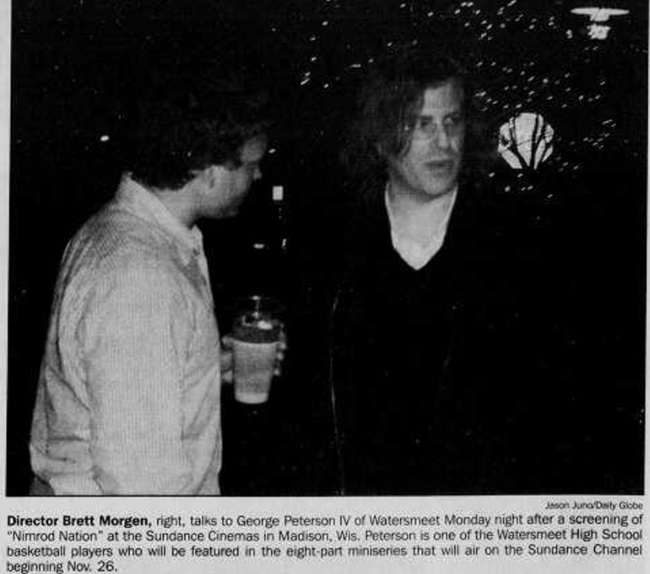 The Nimrods also won constantly early in the 2004-05 season – until Baraga gave them another piece of humble pie. But that proved to be a quick bump in the road. They won their District tournament at home and then both Regional games by double figures.
The Nimrods also won constantly early in the 2004-05 season – until Baraga gave them another piece of humble pie. But that proved to be a quick bump in the road. They won their District tournament at home and then both Regional games by double figures.
Watersmeet then lost a heartbreaker in overtime in the Quarterfinal against Posen, but it didn’t diminish what they had accomplished.
For Peterson, he got to do it with his dad coaching, his brother Jordan playing with him and the whole community cheering for them. He still remembers the bus ride home and the reception they got going through Bruce Crossing, part of the E-TC school district.
“We got to experience something we never got to experience before,” Peterson said. “That was probably one of, if not my favorite, moments from my junior year.”
He learned a lot of lessons from that time in his life — just from playing sports but also from playing for his dad and with the kind of spotlight most small-school athletes don’t see.
“Being an athlete and working in law enforcement, a lot of the lessons learned go hand-in-hand with my profession, because you have to be teachable, you have to be coachable and you have to take the losses,” Peterson said. “Obviously in sports, every time you step foot on the court, we didn’t win. There’s some things in life that you don’t get what you want, but you just learn you gotta work harder for it and strive to be better. That helps me in my profession.”
His dad, who recently retired from coaching boys basketball after walking the sideline for more than three decades, taught his son many things like humility, how to be respectful, patience, and how to respond when things don’t work out.
“That doesn’t mean the door’s closed; you just gotta find a whole different way to get what you want,” Peterson IV said. “I remind myself of that every day when I’m at work.”
As for being in the spotlight, he took valuable lessons from that as well.
“It’s helped me learn to take a step back and not get too excited about certain things,” he said. “Like when I’m around a crowd or when I have stuff going on, like board meetings, or we just have a crowd where people could be mad or people could be in support. It’s helped me to learn to take a step back and mentally just prepare, take that deep breath and everything seems to run smooth.”
2025 Made In Michigan
July 10: Feeding 'Drive to Win,' Loy Norrix Grad Morgan Impresses with Strong USBC Showing - Report
July 9: After Blazing Multiple Volleyball Trails, Bastianelli Charting Next Career Path - Report
PHOTOS (Top) At left, George Peterson IV (12) puts up a jumper playing for Watersmeet in 2004. At right, Peterson holds his son George V while pictured with wife Elise and daughter Braelynn. (Middle) This Ironwood Daily Globe photo from 2007 shows Peterson talking with “Nimrod Nation” director Brett Morgan. (Past photos by Jason Juno; current photos courtesy of the Peterson family.)

